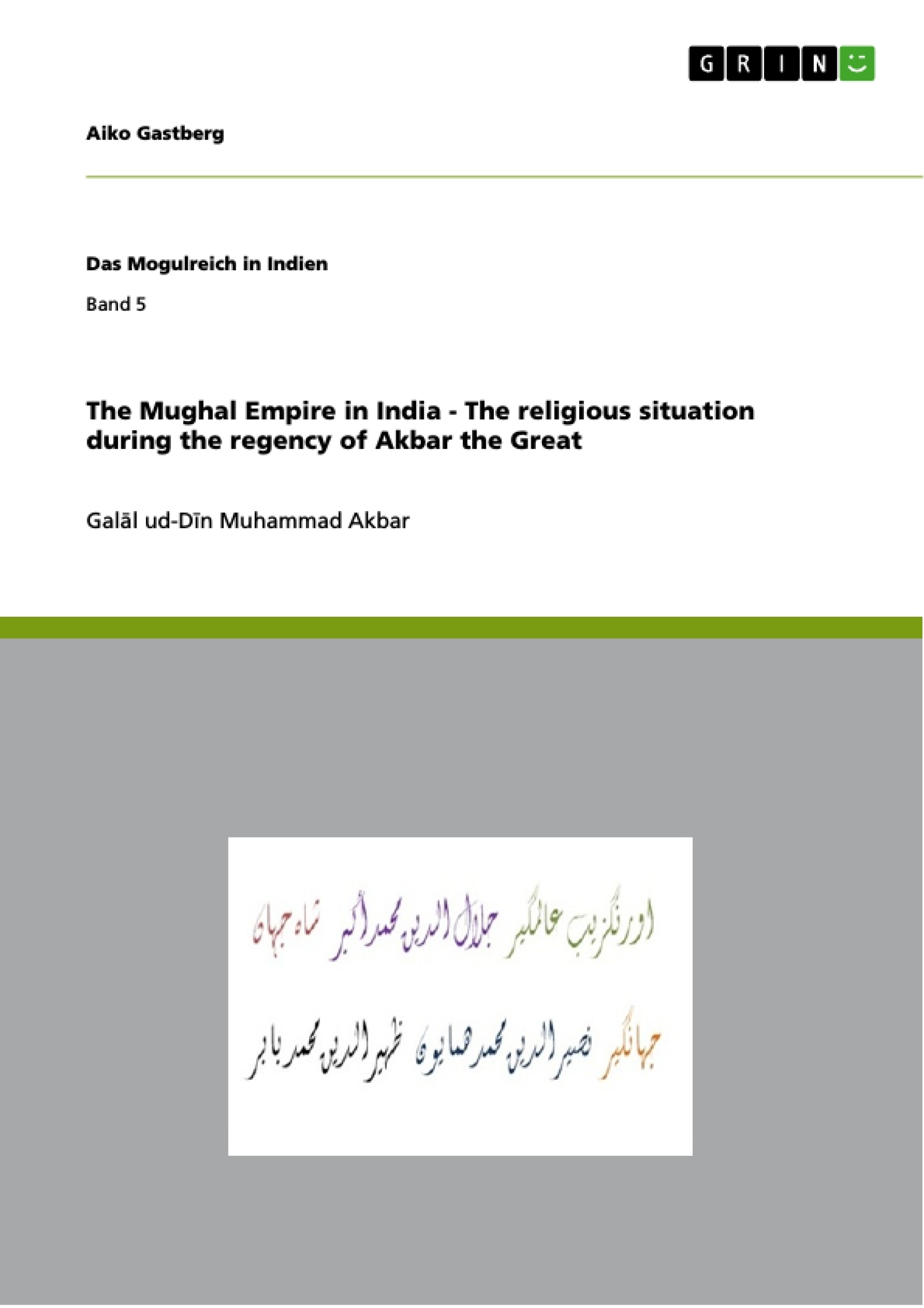The Mughal Empire developed at the beginning of the 16th century in India. Babur (Ẓahīr ud-Dīn Muḥammad Bābur), who overthrew the sultanate of Delhi during the campaign of Panipat against Ibrahim Lodi in 1526 and occupied the cities Delhi and Agra, is considered to be the founder of the Empire. Babur however, died after a regency of only four years in 1530. His son Humayun (Naṣīr ud-Dīn Muḥammad Humāyūn), who was able to form the empire only to a lesser extent, became his successor.
Between 1556 and 1707 the Mughal Empire reached its heyday. Akbar, Jahangir, Shah Jahan and Aurangzeb, the ruling sovereigns during this period, expanded the empire’s borders beyond a large part of the Indian Subcontinent.
Due to the fact that the proportion of Hindus in the empire was significantly greater than the proportion of Muslims, cultural and religious connections often were the result (compare for example Conermann 2006).
1. Introduction
The Mughal Empire developed at the beginning of the 16th century in India. Babur (Ẓahīr ud-Dīn Muḥammad Bābur), who overthrew the sultanate of Delhi during the campaign of Panipat against Ibrahim Lodi in 1526 and occupied the cities Delhi and Agra, is considered to be the founder of the Empire. Babur however, died after a regency of only four years in 1530. His son Humayun (Naṣīr ud-Dīn Muḥammad Humāyūn), who was able to form the empire only to a lesser extent, became his successor.
Between 1556 and 1707 the Mughal Empire reached its heyday. Akbar, Jahangir, Shah Jahan and Aurangzeb, the ruling sovereigns during this period, expanded the empire’s borders beyond a large part of the Indian Subcontinent.
Due to the fact that the proportion of Hindus in the empire was significantly greater than the proportion of Muslims, cultural and religious connections often were the result (compare for example Conermann 2006).
2. Akbar’s planned reforms and the criticism in this regard
Due to these cultural and religious circumstances the Great Mogul Akbar (Ǧalāl ud-Dīn Muḥammad Akbar, 1542-1605) made the attempt to create a “homogenous religion” in the empire, called Dῑn-e ilāhῑ or Tawḥῑd-i ilāhῑ, in order to “create a new religion, which reflected the entire Indian reality.”[1]
Although this attempt is widely admired in modern research, many contemporaries of Akbar were less enthusiastic about it or rejected such a merger (or – as they often called it – falsification) of Islam. (Compare Conermann 2006, p 43)
Scripts, written during the lifetime of Akbar, already indicate contrasting positions concerning the Great Mogul Akbar himself and also towards his views and actions.
Two of these works are particularly contradictory: On the one hand, the Akbar-nāma (the chronicle of the empire), written by the historiograph Abū ‘l-Fażl ʿAllāmī (died 1602) or the ʿAῑn-i-Akbarῑ and on the other hand the Muntaḫabu-’rūḫ respectively the Muntaḫab-ut-Tawārīḫ, written by Badā‘ūnῑ.
While the sovereign Akbar himself and also his work is glorified in Abū ‘l-Fażls chronicle of the court and moreover the syncretism he strives for is justified and supported, the position of
Badā‘ūnῑs is clearly more critical. He himself (as an orthodox Muslim) denies not only the religious ambitions of Akbar, but furthermore also further privileges, which Akbar granted non-Muslims.
This included for example the opportunities for Hindus, to obtain higher grades in the civil service of the sovereign. Also the marriage of Akbar with a Rajput princess and the abolition of the capitation tax for non-Muslims (ǧizya) resulted in strong criticism. Akbar and
Abū ‘l-Fażl never intended to change or reform Islam itself. It was rather the objective to create a doctrine, acceptable to all subjects.
(Compare Conermann 2006, p.54-55)
Thus Conermann continues:
“In this respect, it was first of all necessary to point out the manifold flaws and disadvantages of Islam. Only then, one could begin to develop a religious doctrine, which corresponded with the multi confessional situation in the empire to the same extent as the religious tendency of the sovereign and his advisors. The tawhid-i ilahi or din-i ilahi («God based religion»), as the new confession was called, propagated the universal religious peace (sulh-i kull), on the basis of which uniform standards should be established, which would unite all confessions within the Mughal empire under Akbar’s leadership.” [2]
3. Discussions about religion
During the period between 1570 and 1579 Akbar held regular religious discussions at the court.
These were held in the ibadat-ḫane, the “house of debates”. Representatives of the ʿulamāʾ (religious scholars), Amirs, Sufis and descendants of the prophet, were invited to join these discursive talks.
Conermann describes the prearranged seating as follows: The Sufis were seated in the northern part of the room, the religious scholars in the southern part. The descendants of the prophet took their seats in the western part and the Amirs in the eastern part. (Comp. Conermann 2006, p.56)
Diverse religious philosophical issues concerning Islam were discussed. Since 1578 however, also the representatives of other religions were invited to participate in these religious discussions. Especially in Europe this resulted in an image of Akbar as an exceptionally open minded and tolerant sovereign.[3]
[...]
[1] Cf. Conermann, Stephan: Das Mogulreich – Geschichte und Kultur des muslimischen Indien. München 2006; Originalausgabe, p 8.
[2] Cf. Conermann, Stephan: Das Mogulreich – Geschichte und Kultur des muslimischen Indien. p 55-56.
[3] Cf. Franke, Heike: Akbar und Ǧahāngῑr – Untersuchungen zur politischen und religiösen Legitimation in Text und Bild. Schenefeld 2005; p 73.
- Arbeit zitieren
- Aiko Gastberg (Autor:in), 2012, The Mughal Empire in India - The religious situation during the regency of Akbar the Great, München, GRIN Verlag, https://www.grin.com/document/205967
-

-

-

-
Laden Sie Ihre eigenen Arbeiten hoch! Geld verdienen und iPhone X gewinnen. -

-
Laden Sie Ihre eigenen Arbeiten hoch! Geld verdienen und iPhone X gewinnen. -

-
Laden Sie Ihre eigenen Arbeiten hoch! Geld verdienen und iPhone X gewinnen. -

-
Laden Sie Ihre eigenen Arbeiten hoch! Geld verdienen und iPhone X gewinnen. -

-
Laden Sie Ihre eigenen Arbeiten hoch! Geld verdienen und iPhone X gewinnen.

